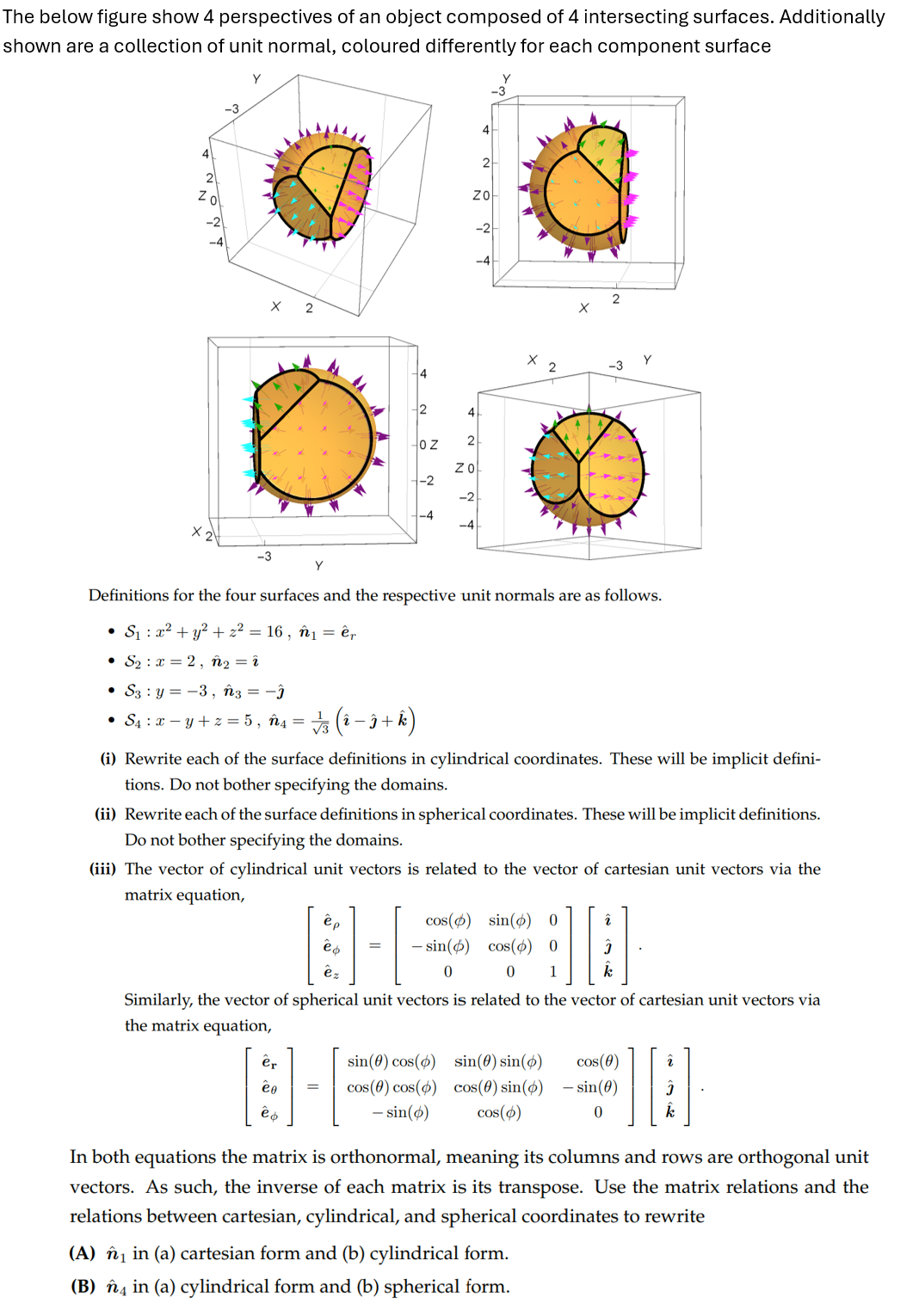The below figure show 4 perspectives of an object composed of 4 intersecting surfaces. Additionally shown are a collection of unit normal, coloured differently for each component surface Zo -3 2 4 4 2 ZO 2 4 OZ 2 X x ZO -2 -4 2 × 2 Definitions for the four surfaces and the respective unit normals are as follows. • S₁ x² + y²+ z² = 16, n₁ = êr S2x=2, n2 = î • S3 y=-3, n3 = −ĵ - • S₁ = x − y + z = 5, ñ4= √3 (1 − 3 + k) (i) Rewrite each of the surface definitions in cylindrical coordinates. These will be implicit defini- tions. Do not bother specifying the domains. (ii) Rewrite each of the surface definitions in spherical coordinates. These will be implicit definitions. Do not bother specifying the domains. (iii) The vector of cylindrical unit vectors is related to the vector of cartesian unit vectors via the matrix equation, ëp cos(0) sin(6) 0 -sin() cos(0) 0 2 0 1 k ёф êz Similarly, the vector of spherical unit vectors is related to the vector of cartesian unit vectors via the matrix equation, er sin(0) cos(6) sin(0) sin(6) cos(0) 2 = Cos(0) cos(6) cos(0) sin(6) - sin(0) ёф - sin() cos(0) 0 k In both equations the matrix is orthonormal, meaning its columns and rows are orthogonal unit vectors. As such, the inverse of each matrix is its transpose. Use the matrix relations and the relations between cartesian, cylindrical, and spherical coordinates to rewrite (A) ₁ in (a) cartesian form and (b) cylindrical form. (B) 4 in (a) cylindrical form and (b) spherical form.
The below figure show 4 perspectives of an object composed of 4 intersecting surfaces. Additionally shown are a collection of unit normal, coloured differently for each component surface Zo -3 2 4 4 2 ZO 2 4 OZ 2 X x ZO -2 -4 2 × 2 Definitions for the four surfaces and the respective unit normals are as follows. • S₁ x² + y²+ z² = 16, n₁ = êr S2x=2, n2 = î • S3 y=-3, n3 = −ĵ - • S₁ = x − y + z = 5, ñ4= √3 (1 − 3 + k) (i) Rewrite each of the surface definitions in cylindrical coordinates. These will be implicit defini- tions. Do not bother specifying the domains. (ii) Rewrite each of the surface definitions in spherical coordinates. These will be implicit definitions. Do not bother specifying the domains. (iii) The vector of cylindrical unit vectors is related to the vector of cartesian unit vectors via the matrix equation, ëp cos(0) sin(6) 0 -sin() cos(0) 0 2 0 1 k ёф êz Similarly, the vector of spherical unit vectors is related to the vector of cartesian unit vectors via the matrix equation, er sin(0) cos(6) sin(0) sin(6) cos(0) 2 = Cos(0) cos(6) cos(0) sin(6) - sin(0) ёф - sin() cos(0) 0 k In both equations the matrix is orthonormal, meaning its columns and rows are orthogonal unit vectors. As such, the inverse of each matrix is its transpose. Use the matrix relations and the relations between cartesian, cylindrical, and spherical coordinates to rewrite (A) ₁ in (a) cartesian form and (b) cylindrical form. (B) 4 in (a) cylindrical form and (b) spherical form.
Algebra & Trigonometry with Analytic Geometry
13th Edition
ISBN:9781133382119
Author:Swokowski
Publisher:Swokowski
Chapter10: Sequences, Series, And Probability
Section10.7: Distinguishable Permutations And Combinations
Problem 21E
Related questions
Question

Transcribed Image Text:The below figure show 4 perspectives of an object composed of 4 intersecting surfaces. Additionally
shown are a collection of unit normal, coloured differently for each component surface
Zo
-3
2
4
4
2
ZO
2
4
OZ
2
X
x
ZO
-2
-4
2
× 2
Definitions for the four surfaces and the respective unit normals are as follows.
• S₁ x² + y²+ z² = 16, n₁ = êr
S2x=2, n2 = î
• S3 y=-3, n3 = −ĵ
-
• S₁ = x − y + z = 5, ñ4= √3 (1 − 3 + k)
(i) Rewrite each of the surface definitions in cylindrical coordinates. These will be implicit defini-
tions. Do not bother specifying the domains.
(ii) Rewrite each of the surface definitions in spherical coordinates. These will be implicit definitions.
Do not bother specifying the domains.
(iii) The vector of cylindrical unit vectors is related to the vector of cartesian unit vectors via the
matrix equation,
ëp
cos(0) sin(6) 0
-sin() cos(0) 0
2
0
1
k
ёф
êz
Similarly, the vector of spherical unit vectors is related to the vector of cartesian unit vectors via
the matrix equation,
er
sin(0) cos(6) sin(0) sin(6)
cos(0)
2
=
Cos(0) cos(6) cos(0) sin(6)
- sin(0)
ёф
- sin()
cos(0)
0
k
In both equations the matrix is orthonormal, meaning its columns and rows are orthogonal unit
vectors. As such, the inverse of each matrix is its transpose. Use the matrix relations and the
relations between cartesian, cylindrical, and spherical coordinates to rewrite
(A) ₁ in (a) cartesian form and (b) cylindrical form.
(B) 4 in (a) cylindrical form and (b) spherical form.
Expert Solution
This question has been solved!
Explore an expertly crafted, step-by-step solution for a thorough understanding of key concepts.
Step by step
Solved in 2 steps

Recommended textbooks for you

Algebra & Trigonometry with Analytic Geometry
Algebra
ISBN:
9781133382119
Author:
Swokowski
Publisher:
Cengage

Elementary Geometry For College Students, 7e
Geometry
ISBN:
9781337614085
Author:
Alexander, Daniel C.; Koeberlein, Geralyn M.
Publisher:
Cengage,

Algebra & Trigonometry with Analytic Geometry
Algebra
ISBN:
9781133382119
Author:
Swokowski
Publisher:
Cengage

Elementary Geometry For College Students, 7e
Geometry
ISBN:
9781337614085
Author:
Alexander, Daniel C.; Koeberlein, Geralyn M.
Publisher:
Cengage,